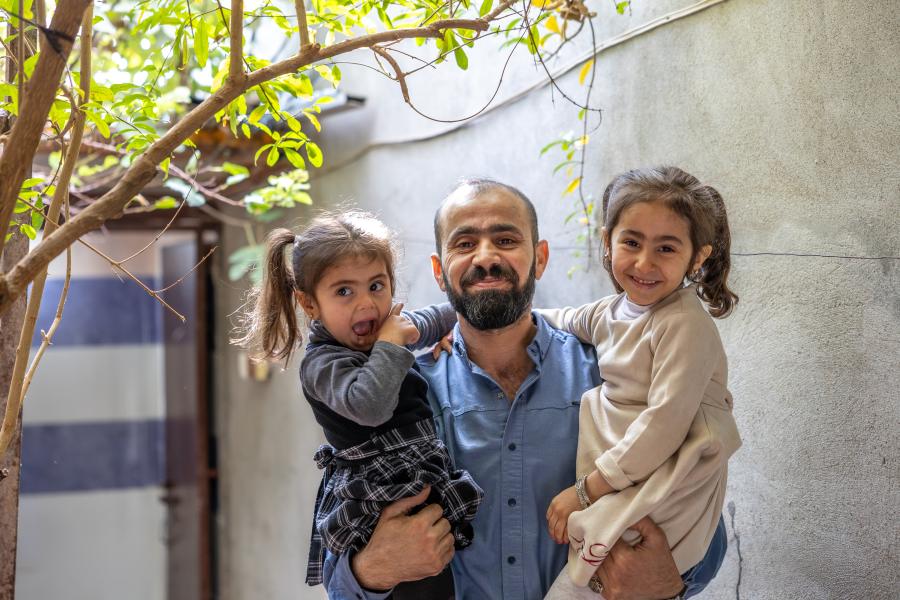Main documents
Iraq still faces protracted humanitarian and development needs, a complex political environment, and a volatile security situation.
The country hosts over 300,000 refugees and asylum-seekers (as of the end of 2023), more than 90% of whom are Syrians (some 270,000). Almost 91% of all the refugees in Iraq live in the Kurdistan Region (KR-I) while the rest reside in central and southern governorates in Federal Iraq. Of the over 270,000 refugees living in the KR-I, 34% reside in nine refugee camps while 66% live in urban settings, primarily in Erbil followed by Dohuk and Sulaymaniyah. The rest of the refugee population (about 27,000) live in Federal Iraq in urban settings, mainly in Baghdad (55%). The Syrian refugees face limited prospects for immediate return, primarily due to the insecurity and challenging living conditions in the North-east region of the Syrian Arab Republic where most of them originate from.
Iraq has an internally displaced population (IDPs) of 1.14 million, some of whom face significant obstacles preventing their return to their homes or successful integration into local communities. In terms of barriers to return, IDPs report insecurity, a lack of livelihood opportunities and financial resources as well as damaged housing in their areas of origin and a perceived affiliation with extremist groups. In addition, 5 million IDPs have already returned and enjoy their rights on par with the rest of the Iraqi population but also face similar challenges.
Given that the remaining protection concerns affecting displaced populations in Iraq predominantly stem from socio-economic factors, human rights deficits and the absence of the rule of law, UNHCR's activities have been transitioning from an emergency response to a more sustainable development approach. In tandem, UNHCR is seeking lasting solutions for IDPs, including facilitating their access to civil documentation and promoting their inclusion in Iraq's social protection systems. UNHCR also continues to pursue efforts to eradicate statelessness in Iraq in line with UNHCR’s Global Action Plan, and the #IBelong Campaign to end statelessness by 2024.
Populations
Population types
Note: The "Stateless" category does not include stateless people who are also in other categories, to avoid double counting. The total number of stateless, across all categories, is .
NB: 2025 figures are planning figures.
Source: UNHCR Refugee Data Finder for years until 2022, UNHCR planning figures (COMPASS) otherwise.
Population by country
NB: 2025 figures are planning figures.
Source: UNHCR Refugee Data Finder for years until 2022, UNHCR planning figures (COMPASS) otherwise.
Population by origin
NB: 2025 figures are planning figures.
Source: UNHCR Refugee Data Finder for years until 2022, UNHCR planning figures (COMPASS) otherwise.
Financials
Budget and expenditure trend
Budget information for the current year is updated monthly, while budget and expenditure information for all other years are final.
Budget by pillar
Budget by objective
Note: The table presents the budget for this operation broken down at the objective level. Resource allocation at the objective level is subject to change during the course of the year as the operational situation evolves and priorities shift. The current budget, reflected in the bottom line of this table, is updated on a monthly basis and is replaced by the final budget at year-end.
Expenditure by Outcome Area
Budget by Impact Area
Source: 2023 budget as approved by the Executive Committee in October 2022.
2022 current budget as approved by the High Commissioner as of October 2022; pending presentation to the ExCom's Standing Committee.
Budget by Outcome and Enabling Areas
Source: 2023 budget as approved by the Executive Committee in October 2022.
2022 current budget as approved by the High Commissioner as of October 2022; pending presentation to the ExCom's Standing Committee.
Budget by Impact Area
Source: 2024 budget and 2023 current budget are taken from the budget document approved by UNHCR's Executive Committee in October 2023.
Budget by Impact Area
Budget information for the current year is updated monthly, while budget and expenditure information for all other years are final.
Budget by Outcome and Enabling Areas
Budget by Outcome and Enabling Areas
Budget information for the current year is updated monthly, while budget and expenditure information for all other years are final.
Budget by Impact Area
Budget by Outcome and Enabling Areas
Strategy
Impact Statements
Latest updates
The boundaries and names shown and the designations used on this map do not imply official endorsement or acceptance by the United Nations.
UNHCR GIS data is publicly accessible in the Operational Data Portal








